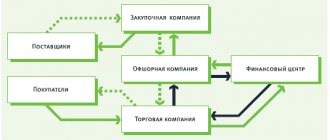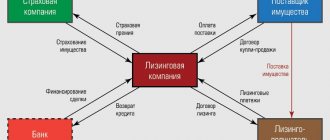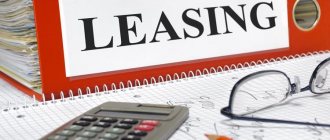Subtleties of calculating depreciation on a leasing object
According to the Tax Code of the Russian Federation, the balance holder of the subject of financial lease, which can be either one or the other party, is required to pay property tax under a leasing agreement.
Article navigation
- Briefly about property tax
- Who pays property tax in leasing
- Property tax using the example of car leasing
- Taxation of a car on the lessee's balance sheet
- Calculation of tax on property on the lessor's balance sheet
- Payment of property tax on a leaseback object
- Tax on leased property after redemption
- conclusions
Property owned by individuals and businesses is subject to taxation. The article highlights the situation in which the owner is one person, and the owner is another. This happens if the item is rented out on a financial lease (also called leasing). Who pays property tax in this case, and how to calculate it?
Tax advantages of leasing
Quite often you can hear that one of the main arguments in favor of leasing is its tax attractiveness. Sometimes even leasing is presented as some kind of independent tax optimization scheme. But in practice, not everything is so simple.
Recently, companies are increasingly willing to acquire fixed assets through a leasing agreement. One of the reasons for the popularity of such deals is the opportunity to save on taxes. Taxation of leasing operations has a number of features regarding income tax, VAT and property tax.
Leasing can be domestic or international. In domestic leasing, the parties to the transaction are residents of the Russian Federation. In international cases, the lessor or lessee are non-residents of our country.
Briefly about property tax
This tax is also called property tax. Property tax is levied on real estate and other objects equated to fixed assets. The assessment of a property when calculating a property tax is carried out not at its residual value, but at its cadastral value.
The tax rate limit is 2.2% established by federal legislation. Regional values may be slightly lower.
Taxation applies to real estate, the ownership of which is legally justified in the following forms:
- trust management;
- temporary possession;
- part of the founding capital.
Property tax refers to direct regional taxes. Tax is calculated on the basis of Chapter 30 of the Tax Code of the Russian Federation. Its main characteristics are summarized in the table for convenience:
| Characteristic | Description |
| Object of taxation | Assets of an enterprise that are fixed assets or equivalent to them |
| Tax base | Average annual value of the asset (based on Article 375 of the Tax Code of the Russian Federation) |
| Tax rate, maximum | 2,2% |
| Subjects of taxation | Russian and foreign enterprises operating in the Russian Federation |
| Tax period | 1 year, until March 30 |
Property leased is classified as fixed assets and is therefore subject to taxation. Another question is who pays it. A finance lease is similar to a purchase on credit:
- the user (owner) receives the item immediately and can use it.
- the cost is paid gradually;
- most often, the lessee, like the credit debtor, pays an initial payment (advance);
- the item is provided to the one indicated by the recipient - in contrast to rent, which involves choosing from the available assortment;
- most often, after the expiration of the financial lease agreement (as well as lending), the leased item belongs to the user;
- As a rule, the object is a completely new thing.
The presence of these similarities determines special rules for taxation of leased items.
Income tax for domestic leasing
Chapter 25 “Organizational Profit Tax” of the Tax Code contains several special provisions related to the taxation of profits under a leasing agreement.
For the lessor, the basis for calculating this tax is the amount of the lease payment excluding VAT. The profit received as a result of the activities of the leasing company will be subject to taxation. By lessor's profit we mean the income received, reduced by the amount of expenses.
When taxing profits, leasing payments are included in other expenses associated with production and sales (subclause 10, clause 1, article 264 of the Tax Code of the Russian Federation).
Who pays property tax in leasing
According to the general rule established in subparagraph 3 of paragraph 12 of Article 378.2 of the Tax Code of the Russian Federation, only the balance holder of the subject of the financial lease is required to pay property tax under a leasing agreement. An exception is the real estate of organizations taxed at cadastral value. Leasing or not, the tax will be paid by the owner or owner with economic management rights (subclause 3, clause 12, article 378.2 of the Tax Code of the Russian Federation).
It should be remembered that the parties to the financial lease agreement themselves decide who will accept the leased asset on their balance sheet. This right is provided for by the Methodological Guidelines for Accounting, approved by Order of the Ministry of Finance of the Russian Federation No. 91n dated October 13, 2003 (clause 50).
In other words, both the lessor and the lessee can be the balance holder and the tax payer, depending on what agreement they come to. This decision must be recorded in the contract.
There are no questions if the lessor and the balance holder are the same legal entity. If the lessee has registered the item, then his accounting department must itself calculate depreciation, calculate the amount of the property fee and transfer it to the budget.
Property tax using the example of car leasing
A car is one of the most common leased items: using its example, you can look at how movable property tax is calculated. In this case, the amount of obligations itself is calculated according to the same scheme:
- The object is registered at the cost of acquisition.
- The depreciation amount is written off every month.
- The average annual value of property is determined as the arithmetic average of the cost of the item for each month (their sum is divided by 12).
- The result is multiplied by the tax rate and divided by 100.
Taxation of a car on the lessee's balance sheet
After leasing the car, the lessor records it in off-balance sheet account 011 as a leased fixed asset. From this moment on, he does not bear a fiscal burden, since the lessee pays the property tax and puts the item on his balance sheet (Tax Code of the Russian Federation, paragraph 1, Article 374).
The accountant of the balance sheet holder makes the following entries to place the fixed asset on the balance sheet of the enterprise:
| Correspondence | Operation description | |
| Dt | CT | |
| 08 | 76 | Registration of leased property at the initial full cost |
| 01 | 08 | Enrollment of leased property into fixed assets |
| 76 | 02 | Monthly deduction of depreciation amount from the subaccount of the cost of the leased asset |
After calculating the average annual cost and the amount of the property fee, the property tax is paid to the budget by March 30, which is on the balance sheet of the lessee enterprise. The transaction is reflected in account 68 “Calculations for taxes and fees”.
It is worth noting that it is much more profitable for an enterprise to leave a car on the balance sheet of a leasing company. This will significantly reduce the lessee's tax expenses. You can read about other nuances of car leasing in this article.
Calculation of tax on property on the lessor's balance sheet
The absence of the need to keep records of a fixed asset is one of the advantages of leasing, so the item most often remains on the balance sheet of the owner company, that is, the lessor. He also calculates depreciation, according to which the amount of tax liability for property collection is calculated (clause 1 of Article 374 of the Tax Code of the Russian Federation).
Property leased from the lessor is accounted for by the following entries:
| Correspondence | Operation description | |
| Dt | CT | |
| 60 | 51 | Payment of the supplier's invoice for the leased item |
| 08 | 60 | Reflection of acquisition costs |
| 19 | 60 | Accounting for input VAT |
| 03 | 08 | Capitalization of the leased asset as a profitable investment (using a special subaccount) |
| 68 | 19 | Acceptance of VAT for deduction |
| 03 | 03 | Correspondence of subaccounts “Property intended for leasing” and “Property transferred for leasing” (transfer of an object) |
| 20 | 02 | Depreciation charges (every month), starting from the month following the date of transfer of the item for leasing |
The accrual and payment of the property tax is based on the average annual value, the calculation of which is described above.
You can read more about the calculation of depreciation by enterprises for leasing objects by following the link.
Payment of property tax on a leaseback object
A natural question arises about the taxation of property transferred under leaseback. In this case, the lessee is the former owner of the item, who sold it and took a financial lease. At the same time, in most cases he remains the balance holder.
Movable property leased from the beginning of 2013 under leaseback is exempt from taxation if the relationship between the lessor and the lessee is not interdependent. Otherwise, there would be evasion of tax obligations to the budget with the collusion of affiliated entities.
Movable assets listed on the balance sheet as fixed assets or equivalent to them are subject to property tax, with the exception of:
- belonging to both the 1st and 2nd groups of depreciation according to OKOF;
- accepted for balance sheet accounting from January 1, 2013 (with the exception of transfers between affiliated enterprises received during liquidation and reorganization - in accordance with Article 381 of the Tax Code of the Russian Federation).
How is leasing tax calculated?
The criteria for calculating the amount of the transport fee are:
- Engine power. It is determined in horsepower;
- Tax rate per horsepower, separately adopted in each subject of the federation.
During the term of the leasing transaction, the state tax is calculated according to the usual scheme, as in any other cases. The exception is the last month , when the redemption payment is made and ownership passes to the user.
This month, difficulties arise if the tax was initially paid by the leasing company, and its expenses were included in monthly payments. In standard cases (outside leasing), the car fee is charged for the entire month. In this regard, the new owner would have to pay the fee twice: in the form of a monthly payment, which already includes its amount, and the tax itself, paid on his own behalf.
To avoid double taxation, a specific condition is included in the agreement. On its basis, the new owner pays a state fee for the actual number of days of the month in which he was the official owner. The portion already paid by the leasing company is added to this amount. Thanks to this, the tax authorities have no claims against the new owner of the vehicle.
Tax on leased property after redemption
After the end of the contract, the leased asset can be returned to the owner or purchased by the lessee. The procedure for calculating the property tax in both cases is similar, and the only difference is who will pay it from the moment of redemption until full depreciation.
Buy-out during a commercial lease is possible if no more than 75% of the initial cost of the leased asset remains on the balance sheet. When it is returned, nothing changes for the lessor - he continues monthly depreciation.
The transfer of the item into the ownership of the lessee changes the situation. The owner (user) becomes the owner. If he did not register the property, now in any case he will have to do this by making the following entries:
| Correspondence | Operation description | |
| Dt | CT | |
| 02 (subaccount “depreciation of leased property”) | 01 | Write-off of depreciation accrued over the term of the leasing agreement |
| 76 | 01 | Write-off of the residual value of leased property |
| 08 | 60 | Purchasing an item |
| 60 | 51 | Reflection of payment for the object to the lessor |
| 01 | 08 | Placing an item on balance sheet |
Depreciation will be calculated on the residual (redemption) value from the 1st day of the month following the registration of the purchased fixed asset.
Property tax is charged in the general manner - once a year based on the average annual value of the asset, by multiplying it by the interest rate prevailing in the region. As it is used and over time, its amount will decrease according to a pattern corresponding to the depreciation method adopted by the enterprise.
Black and white leasing
Separately, I would like to say about the pseudo-legal method of tax saving, covered by a leasing agreement.
More recently, some consulting companies proposed optimizing taxes through leasing operations. The meaning of such proposals was the “sale” of paid VAT, that is, the opportunity to offset these amounts for one’s activities.
The essence of such a “leasing scheme” is as follows. A leasing company purchases property to lease to a client and records it on its balance sheet. Further, the equipment is transferred to the lessee, who performs his duties in bad faith and does not actually pay lease payments. The lessor has an overpayment of VAT, which they propose to use. Sometimes the scheme involves an insurance company that insures the property.
It may seem that there is nothing illegal in such a proposal. But it is necessary to analyze this scheme completely.
If you look at such models a little more broadly, you will notice that they are all aimed at artificially creating a situation where the tax paid exceeds the amount of tax received.
It is clear that situations with overpayment of taxes often arise without any minimization. There is only a shift of the tax burden along the chain of sales of goods, but the tax goes to the budget.
It’s another matter when such an overpayment is created precisely as a product for further sale. In this case, the optimizers’ task does not include paying taxes. Therefore, all such schemes are limited to banal fly-by-night companies.
When using such a scheme, there is a risk that the authorized bodies will recognize a preliminary conspiracy aimed at non-payment of taxes to the budget. As a result of this, persons involved in the transaction may be subject to criminal liability.
Value added tax (VAT)
VAT will depend on the main factor - whether the lease payment is divided into parts. Let's consider both options:
- The payment is split. In this case, the amount of VAT is reduced by VAT on the rental part of the payment. But the tax on the redemption portion can be deducted only after the full redemption occurs.
- Payment is not split. The tax is reduced by the amount specified in the invoice and the acceptance certificate upon expiration of the tax period.
The lessor accepts VAT from the value of the property for deduction at the time of registration of the leased asset and if there is an invoice from the seller.
“Redemption value” of leased property
Claims from tax authorities regarding the accounting procedure for tax purposes by lessees of the redemption value of leased property are of a long-standing nature. Currently, tax authorities have agreed on the legality of lessees deducting VAT from lease payments during the period of provision of relevant services and receipt of an invoice, regardless of whether the redemption value is included in the lease payment or not, whether the redemption value is allocated or not (letter from the Ministry of Finance of Russia dated 07.07.2006 No. 03-04-15/131). However, claims continue to be made about the impossibility of including the redemption value (especially if it is not allocated as part of lease payments) as part of income tax expenses (letter of the Ministry of Finance of Russia dated 02/06/2012 No. 03-03-06/1/71) and simplified tax system. Without going into details, we can say that there is extensive arbitration practice on this issue. The judges fully support taxpayers in their right not to allocate the redemption value of the leased asset and at the same time include the entire amount of the lease payment as expenses. Thus, the Supreme Arbitration Court of the Russian Federation in its determination (Definition of the Supreme Arbitration Court of the Russian Federation dated October 10, 2007 No. 12038/07) indicated that “the inspection’s conclusion that the cost of the redemption price of the property should be separated from the amount of the lease payment and excluded from expenses that reduce taxable profit, is not based on the provisions of Chapter 25 of the Tax Code of the Russian Federation.”






